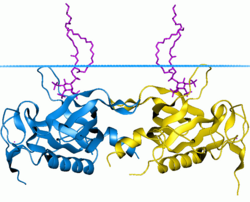 PH domain of tyrosine-protein kinase BTK | |||||||||
| Identifiers | |||||||||
|---|---|---|---|---|---|---|---|---|---|
| Symbol | PH | ||||||||
| Pfam | PF00169 | ||||||||
| Pfam clan | CL0266 | ||||||||
| ECOD | 220.1.1 | ||||||||
| InterPro | IPR001849 | ||||||||
| SMART | PH | ||||||||
| PROSITE | PDOC50003 | ||||||||
| SCOP2 | 1dyn / SCOPe / SUPFAM | ||||||||
| OPM superfamily | 49 | ||||||||
| OPM protein | 1pls | ||||||||
| CDD | cd00821 | ||||||||
| |||||||||
Pleckstrin homology domain (PH domain) or (PHIP) is a protein domain of approximately 120 amino acids that occurs in a wide range of proteins involved in intracellular signaling or as constituents of the cytoskeleton.[1][2][3][4][5][6][7]
This domain can bind phosphatidylinositol lipids within biological membranes (such as phosphatidylinositol (3,4,5)-trisphosphate and phosphatidylinositol (4,5)-bisphosphate),[8] and proteins such as the βγ-subunits of heterotrimeric G proteins,[9] and protein kinase C.[10] Through these interactions, PH domains play a role in recruiting proteins to different membranes, thus targeting them to appropriate cellular compartments or enabling them to interact with other components of the signal transduction pathways.
- ^ Mayer BJ, Ren R, Clark KL, Baltimore D (May 1993). "A putative modular domain present in diverse signaling proteins". Cell. 73 (4): 629–30. doi:10.1016/0092-8674(93)90244-K. PMID 8500161. S2CID 44282241.
- ^ Haslam RJ, Koide HB, Hemmings BA (May 1993). "Pleckstrin domain homology". Nature. 363 (6427): 309–10. Bibcode:1993Natur.363..309H. doi:10.1038/363309b0. PMID 8497315. S2CID 4334376.
- ^ Musacchio A, Gibson T, Rice P, Thompson J, Saraste M (September 1993). "The PH domain: a common piece in the structural patchwork of signalling proteins". Trends in Biochemical Sciences. 18 (9): 343–8. doi:10.1016/0968-0004(93)90071-T. PMID 8236453.
- ^ Gibson TJ, Hyvönen M, Musacchio A, Saraste M, Birney E (September 1994). "PH domain: the first anniversary". Trends in Biochemical Sciences. 19 (9): 349–53. doi:10.1016/0968-0004(94)90108-2. PMID 7985225.
- ^ Pawson T (February 1995). "Protein modules and signalling networks". Nature. 373 (6515): 573–80. Bibcode:1995Natur.373..573P. doi:10.1038/373573a0. PMID 7531822. S2CID 4324726.
- ^ Ingley E, Hemmings BA (December 1994). "Pleckstrin homology (PH) domains in signal transduction". Journal of Cellular Biochemistry. 56 (4): 436–43. doi:10.1002/jcb.240560403. PMID 7890802. S2CID 23154429.
- ^ Saraste M, Hyvönen M (June 1995). "Pleckstrin homology domains: a fact file". Current Opinion in Structural Biology. 5 (3): 403–8. doi:10.1016/0959-440X(95)80104-9. PMID 7583640.
- ^ Wang DS, Shaw G (December 1995). "The association of the C-terminal region of beta I sigma II spectrin to brain membranes is mediated by a PH domain, does not require membrane proteins, and coincides with a inositol-1,4,5 triphosphate binding site". Biochemical and Biophysical Research Communications. 217 (2): 608–15. doi:10.1006/bbrc.1995.2818. PMID 7503742.
- ^ Wang DS, Shaw R, Winkelmann JC, Shaw G (August 1994). "Binding of PH domains of beta-adrenergic receptor kinase and beta-spectrin to WD40/beta-transducin repeat containing regions of the beta-subunit of trimeric G-proteins". Biochemical and Biophysical Research Communications. 203 (1): 29–35. doi:10.1006/bbrc.1994.2144. PMID 8074669.
- ^ Yao L, Kawakami Y, Kawakami T (September 1994). "The pleckstrin homology domain of Bruton tyrosine kinase interacts with protein kinase C". Proceedings of the National Academy of Sciences of the United States of America. 91 (19): 9175–9. Bibcode:1994PNAS...91.9175Y. doi:10.1073/pnas.91.19.9175. PMC 44770. PMID 7522330.